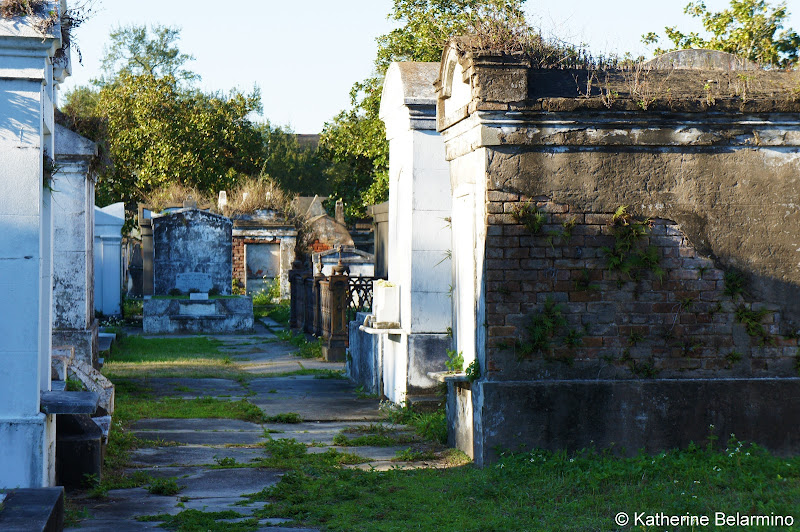I love cemeteries and whenever we see cemeteries when we travel, we always stop to explore. New Orleans’ cemeteries are famous for their history, beauty, and uniqueness. We joined two New Orleans cemetery tours to learn why New Orleans’ cemeteries are so unique.
Our first New Orleans cemetery tour was a combined tour that visited both the 1833 Lafayette Cemetery No. 1 and the surrounding Garden District. The 1833 Lafayette Cemetery No. 1 is the prettiest of the cemeteries near the French Quarter. The combination of above-ground tombs, cracked stone, and green overgrowth make the cemetery both photogenic and spooky.
New Orleans’ cemeteries aren’t filled with above-ground tombs just because they're pretty. When the residents of New Orleans tried to dig graves in the ground, they would hit water and have to drill holes in the coffins, put them in water, and hope it didn’t rain. New Orleans gets around five feet of rain a year. If it rained, the coffins could potentially resurface.
One way to solve this problem would be to bury the dead on higher ground, but they didn’t want to use high ground for cemeteries as they wanted to use those areas, like the French Quarter and Uptown, to live. The solution was to use above-ground tombs.
The tombs found in New Orleans cemeteries are family tombs. Historically, New Orleans residents were Catholic. Until 1963, the Catholic religion said you couldn’t get into heaven if you were cremated, so somehow generations of New Orleanians had to fit into one tomb.
Tombs can fit anywhere from one to three caskets at a time. Whenever there is a death, the tablet at the front of the tomb is removed, the brick and mortar is broken, the coffin is placed inside, the brick and mortar is replaced, the name is added to the tablet, and the tablet is put back on the tomb. The interior of the tombs can get up to 102 degrees, which causes accelerated decomposition (not the loveliest of terms). Remains must be left in the tomb a minimum of one year and one day. If a tragedy occurs and more family members die than can be fit in the tomb or before the necessary time has passed, a wall vault can be rented. The next time there is a death in the family, the coffin in the tomb is taken out, the decomposed remains are gathered and put into the back of the tomb with the other occupants, and the process starts all over again.
It’s fascinating to wander through the cemetery, reading the tombs and imagining what the families inside were like when they were alive, though it gets a little spooky late in the day when the sun starts setting. You can learn the history of some of the families during a New Orleans cemetery tour.
Family tombs are owned like houses and it is the responsibility of the family to maintain the tomb. One tomb in the Lafayette Cemetery has been in the same family since 1858. On All Saints Day, families visit family tombs and picnic, drink wine, and socialize with their tomb neighbors.
While walking amongst the tombs, pay attention to the symbols on the tombs. Every symbol has a meaning. Inverted torches mean a life snuffed out. A rose means Mary mother of Jesus. A winged hourglass means that time flies.
New Orleanians put the “fun” in funeral. Jazz funerals are common in New Orleans. Jazz funerals include the hearse, the family, a brass band, and the second line consisting of friends, acquaintances, and strangers. Mournful music is played on the way to the cemetery and joyful music is played leaving the cemetery because the loved one has gone to a better world. When traveling to New Orleans, read the obituaries, find a jazz funeral, and join a second line. Strangers are welcome.
The other New Orleans cemetery tour we joined was a Cemetery Voodoo Tour. This tour visits the St. Louis Cemetery No. 1 just outside the French Quarter. The St. Louis Cemetery is not as photogenic as the Lafayette Cemetery, but it is older, built in 1789, and has some famous and historic residents like the voodoo queen Marie Leboux, Madame LaLaurie, and Homer Plessy. Interestingly, while slaves were buried in family tombs with their Catholic owners, Protestants were segregated and buried in a separate section. There is also a wall vault built in 1903 that contains the remains of people who emigrated from places like Haiti, France, Cuba, and Spain. Note that this cemetery can only be visited on a guided tour.
We took our Garden District and Cemetery Voodoo walking tours with Historic New Orleans Tours, Inc. Tours are small and cost $20 per person. Reservations are not required.
Thank you to the New Orleans Convention and Visitors Bureau and the New Orleans Hotel Collection for hosting our trip to New Orleans and making this post possible. As always, all opinions are my own. For updates on what is going on in New Orleans, follow the New Orleans CVB on Facebook, Twitter, and Instagram.









